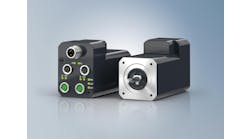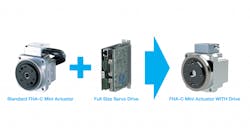Just when it seems like today’s sophisticated motors and drives can’t possibly add more efficiencies and capabilities, engineers conjure up new tricks and refinements, followed by end users and system integrators who materialize new settings and challenges where they can make big gains. As usual, the rest of us are left to wonder, “How did they do that?”
This is because, while long-established drives and motor solutions might not appear unusual to most technical professionals and other onlookers, they obviously manifest as lifesavers to those most in need of their capabilities. Necessity doesn’t just lead to invention, it grants new vision along the way.
One company with this mindset is Acadian Seaplants in Dartmouth, Nova Scotia, Canada, which grows and processes agricultural biostimulants in liquid and powdered forms at its plant in nearby Cornwallis. The company starts with local, sustainably harvested ascophyllum nodosum seaweed, from which various bioactive compounds are extracted, clarified, filtered and concentrated in a complex production process that requires careful process control. The final products are shipped to more than 80 countries to improve the health and growth of plants worldwide.
Growing gracefully
“Our motor controls and facility communications were hardwired before 2006, so if we wanted to change or add a step in the production process, we’d often to rewire entire areas of the facility,” says Wade Hazel, engineering manager at Acadian. “We began automating the Cornwallis facility during 2006-2008, but this modernization wasn’t enough to meet growing demand, so we decided to build onto the existing plant to add capacity, and automate the new equipment to increase process control and efficiency.”
Hazel adds that Acadian supplier Graybar knew it was already using Allen-Bradley CompactLogix programmable automation controllers (PACs) from Rockwell Automation, so it proposed adding Allen-Bradley Centerline motor control centers (MCCs) with IntelliCenter software and EtherNet/IP networking. This meant Acadian could expand its capacity by integrating with existing controllers, and avoid adding hardwiring for motor controls (Figure 1). Consisting of variable-speed drives (VSD) and full-voltage starters, the MCCs and supporting automation let Acadian increase seaweed processing by 50% during 2008-09.
[sidebar id =1]
However, demand continued to swell, so Acadian’s management decided to build the new Deveau Center plant across the street with three times the space. This included underground piping for moving product between the plants, three more ControlLogix PACs, expanded Centerline and Intellicenter applications, plantwide EtherNet/IP for monitoring and motion control, and Rockwell Software Studio 5000 to set up and configure the PACs and MCCs. The new plant was finished in 2014, and it’s already running at 40% more capacity than its earlier version, and can expand capacity another 250%.
“This facility isn’t static,” added Hazel. “We may need to change functions one day, do improvements the next, or add new processes. With all controls connected via EtherNet/IP, many former hardwires became virtual wires, so we can make changes faster at a lower cost. Integrated MCCs and controllers give us a more connected, reliable and continuous facility with data shared more seamlessly between processes and operators. Engineers can also access the plant’s computer remotely to reduce downtime compared to former onsite visits.
“Based on the plant science division’s successful expansion, our engineering team has started using CompactLogix PACs to automate processes in the food science division’s land-based cultivation facility, and we’d like to migrate to EtherNet/IP-enabled MCCs in the animal science division in the next few years,” adds Hazel.
Rotating evolution
Integrating microprocessors, intelligence, networking and other functions into motors and drives enable them to achieve remarkable gains, but these advances have also altered their basic nature. “Process and discrete controls are more the same now, and their technologies are adapting to fit,” says Robert Soré, product marketing manager for general-purpose, Sinamic and VG drives, Siemens. “PLCs and other process controllers aren’t much different now, and many drives are much the same, even though their AC motors may run at different speeds. In fact, increasing pressure for efficiency has pushed drives to evolve until they can now do what servo drives did just a few years ago.”
Because they’re easier and less costly to deploy, drives are spreading to rotating equipment that hasn’t used them before, according to Soré. “Over the past five to seven years, drives are appearing on more pump jacks, fans, pumps and positive-displacement pumps. These used to have contactors and starters because there were less concerns about saving power. However, with the oil and gas industry down, people want to save money, and they’re doing it with smaller, smarter and less costly drives, and more precise variable-frequency drives (VFD).”
Soré adds that similar efforts to save are spurring adoption of more efficient, relatively higher-tech motors, such as synchronous reluctance motors. “A manufacturer may add variable speed to a motor that usually runs at full speed and 60 Hz, but then it’s only 40-50% efficient at half speed,” he explains. “Synchronous reluctance gets that efficiency back up to 70% at half speed, which is why we’re rolling them out.”
Tough, old environment? No problem
Thanks to these and other enhanced capabilities, size reductions and lower costs, users are increasingly willing to apply new motors and drives in difficult environments, and replace aging equipment they couldn’t remove before.
At the Chuquicamata open-pit copper mine in Chile, state-owned Codelco recently began developing an underground mine to access an ore body beneath the pit. The new mine is scheduled to begin operations in 2019 and expand “Chuqui’s” capacity, but one major hurdle is it will need one of the world’s largest, most complex and most powerful conveyor systems to get copper ore up steep gradients and over long distances to its concentrator plant 13 km away (Figure 2). As a result, Codelco recently contracted with Tenova Takraf GmbH to build the conveyor system, and Takraf enlisted ABB to automate it. So far, it’s designed to have conveyor flights powered by up to 20 MW and a total requirement of 55 MW, which will allow it to transport more than 11,000 tons of material per hour.
[sidebar id =2]
ABB will implement a complete power and automation solution at Chuqui, including gearless drives, motors, instrumentation and power components, which will be custom engineered to meet onsite requirements to optimize power, control, measure and actuate the conveyor. This design will integrate the belt’s power and automation through ABB’s 800xA control system, and combine with its Mining Conveyor Control Program (MCCP) to ensure optimum power quality and control.
“The gearless conveyor drive system is a key feature of the solution because it meets the conveyor’s extremely high load requirements and necessary power availability, which wouldn’t have been achievable with a conventional drive solution,” says Roger Bailey, head of ABB’s Process Industries division. “The gearless drive system eliminates the gearbox from the motor, which reduces part wear and required maintenance. Another advantage is the reduction in the drive system footprint and instrumentation required. Less parts increases reliability and efficiency of the overall conveyor system by several percentage points.”
Similarly, Tech Folien Ltd. in Liverpool, U.K., recently needed to replace the 15-year-old motor/drive system on its extruder due to lacking spare parts and excessive energy consumption. The firm produces polycarbonate, polypropylene and other co-extruded, blown films. As a result, Emerson Automation Solutions and Rewinds & J. Windsor (RJW) combined a Unidrive M701 VSD from Control Techniques and an energy-efficient IE4 LSRPM motor from Leroy-Somer, both Emerson Industrial Automation firms.
Installed in a cabinet away from the line, the M701 sets the speed control parameters of the motor, which is installed close to the line. Control parameters are programmed via onboard drive macros. Emerson and RJW’s solution is expected to save the extruder and Tech Folien about 75% on its energy costs. “Energy efficiency plays a vital role in ensuring our profitability, and this new drive and motor combination ensures that we have complete confidence that we can control our energy costs and maintain 24/7 operation,” says David Churm, maintenance manager at Tech Folien.
Finally, located in the heart of Tata Steel Europe’s Hartlepool SAW pipe mill in northeastern England is an expander machine that shapes, sizes and strengthens its pipe products with help from a large gripper car and 40-year-old DC motor, which moves 12.5-meter pipes over the expander’s head. Used only for pipe making, this machine is unique in the U.K. However, the old motor also required frequent maintenance (and DC drives and spare parts were scarce), consumed too much energy, and was hobbled by an obsolete, inaccurate and slow control system that often caused production bottlenecks (Figure 3).
[sidebar id =3]
Consequently, Tata sought help from Rockwell Automation and CP Automation to find a replacement. “Requirements for better energy efficiency and accuracy meant an off-the-shelf motor and drive wouldn’t suffice, so we worked with Vascat to produce a bespoke, 150-kW motor at 300 A and 1,070 rpm, and Rockwell supplied its 250-kW Powerflex 755 inverter drive with CIP Motion function and PLC,” says John Mitchell, global business development manager at CP.
To boost the new motor’s start/stop speed and prevent drive trips, CP introduced a Revcon regenerative braking unit to make start/stops more seamless, accelerate the gripper car, and move the pipes faster. The old motor was replaced in August 2016, and Tata had also planned to replace the expander’s auxiliary drive later in 2016.
“The regenerative unit is where we reaped the benefits of the new equipment, both in increased speed and energy efficiency,” says Tony Brown, electronics engineer at Tata Steel. “Also, the new servo drive’s accuracy allows us to position pipe with 1-mm accuracy, whereas the old DC system’s accuracy was closer to 50 mm. This improved accuracy coupled with a 10% increase in speed gives us productivity improvements throughout the expander.”
[sidebar id =4]




